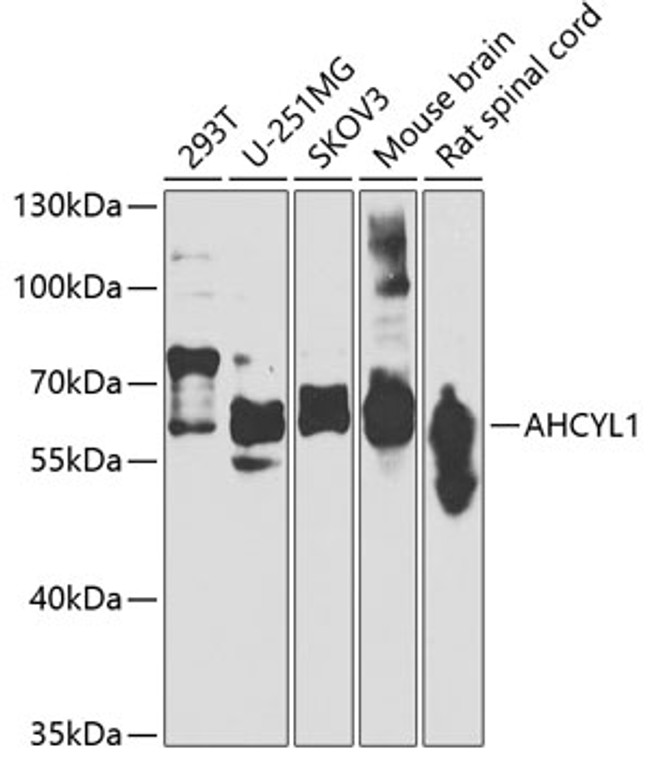| Host: |
Rabbit |
| Applications: |
WB |
| Reactivity: |
Human/Mouse/Rat |
| Note: |
STRICTLY FOR FURTHER SCIENTIFIC RESEARCH USE ONLY (RUO). MUST NOT TO BE USED IN DIAGNOSTIC OR THERAPEUTIC APPLICATIONS. |
| Short Description: |
Rabbit polyclonal antibody anti-AHCYL1 (31-260) is suitable for use in Western Blot research applications. |
| Clonality: |
Polyclonal |
| Conjugation: |
Unconjugated |
| Isotype: |
IgG |
| Formulation: |
PBS with 0.02% Sodium Azide, 50% Glycerol, pH7.3. |
| Purification: |
Affinity purification |
| Dilution Range: |
WB 1:500-1:2000 |
| Storage Instruction: |
Store at-20°C for up to 1 year from the date of receipt, and avoid repeat freeze-thaw cycles. |
| Gene Symbol: |
AHCYL1 |
| Gene ID: |
10768 |
| Uniprot ID: |
SAHH2_HUMAN |
| Immunogen Region: |
31-260 |
| Immunogen: |
Recombinant fusion protein containing a sequence corresponding to amino acids 31-260 of human AHCYL1 (NP_006612.2). |
| Immunogen Sequence: |
MATVTKAPKKQIQFADDMQE FTKFPTKTGRRSLSRSISQS STDSYSSAASYTDSSDDEVS PREKQQTNSKGSSNFCVKNI KQAEFGRREIEIAEQDMSAL ISLRKRAQGEKPLAGAKIVG CTHITAQTAVLIETLCALGA QCRWSACNIYSTQNEVAAAL AEAGVAVFAWKGESEDDFWW CIDRCVNMDGWQANMILDDG GDLTHWVYKKYPNVFKKIRG IVEESVTGVH |
| Tissue Specificity | Expressed in dendritic cells. |
| Post Translational Modifications | Phosphorylated at Ser/Thr residues between Ser-68 and Thr-72 in the PEST region: required for interaction with dATP-bound RRM1 and ITPR1. Phosphorylation at Ser-68 by PRKD1 and CAMK4 is required for further phosphorylations by CSNK1A1. Phosphorylation is induced by oxidative stress. Probably phosphorylated by CAMK2A.phosphorylation at Ser-68 may be required for interaction with SLC9A3. Dephosphorylated in response to apoptotic stress conditions which causes translocation of both AHCYL1 and BCL2L10 from mitochondria-associated endoplasmic reticulum membranes and promotes apoptosis. |
| Function | Multifaceted cellular regulator which coordinates several essential cellular functions including regulation of epithelial HCO3(-) and fluid secretion, mRNA processing and DNA replication. Regulates ITPR1 sensitivity to inositol 1,4,5-trisphosphate, competing for the common binding site and acting as endogenous 'pseudoligand' whose inhibitory activity can be modulated by its phosphorylation status. Promotes the formation of contact points between the endoplasmic reticulum (ER) and mitochondria, facilitating transfer of Ca(2+) from the ER to mitochondria. Under normal cellular conditions, functions cooperatively with BCL2L10 to limit ITPR1-mediated Ca(2+) release but, under apoptotic stress conditions, dephosphorylated which promotes dissociation of both AHCYL1 and BCL2L10 from mitochondria-associated endoplasmic reticulum membranes, inhibits BCL2L10 interaction with ITPR1 and leads to increased Ca(2+) transfer to mitochondria which promotes apoptosis. In the pancreatic and salivary ducts, at resting state, attenuates inositol 1,4,5-trisphosphate-induced calcium release by interacting with ITPR1. When extracellular stimuli induce ITPR1 phosphorylation or inositol 1,4,5-trisphosphate production, dissociates from ITPR1 to interact with CFTR and SLC26A6, mediating their synergistic activation by calcium and cAMP that stimulates the epithelial secretion of electrolytes and fluid. Also activates basolateral SLC4A4 isoform 1 to coordinate fluid and HCO3(-) secretion. Inhibits the effect of STK39 on SLC4A4 and CFTR by recruiting PP1 phosphatase which activates SLC4A4, SLC26A6 and CFTR through dephosphorylation. Mediates the induction of SLC9A3 surface expression produced by Angiotensin-2. Depending on the cell type, activates SLC9A3 in response to calcium or reverses SLC9A3R2-dependent calcium inhibition. May modulate the polyadenylation state of specific mRNAs, both by controlling the subcellular location of FIP1L1 and by inhibiting PAPOLA activity, in response to a stimulus that alters its phosphorylation state. Acts as a (dATP)-dependent inhibitor of ribonucleotide reductase large subunit RRM1, controlling the endogenous dNTP pool and ensuring normal cell cycle progression. In vitro does not exhibit any S-adenosyl-L-homocysteine hydrolase activity. |
| Protein Name | S-Adenosylhomocysteine Hydrolase-Like Protein 1Dc-Expressed Ahcy-Like MoleculeIp(3rs Binding Protein Released With Ip(3IrbitPutative Adenosylhomocysteinase 2S-Adenosyl-L-Homocysteine Hydrolase 2Adohcyase 2 |
| Database Links | Reactome: R-HSA-112043Reactome: R-HSA-1489509Reactome: R-HSA-2029485Reactome: R-HSA-2871809Reactome: R-HSA-422356Reactome: R-HSA-5218921Reactome: R-HSA-5578775Reactome: R-HSA-5607763Reactome: R-HSA-9664323Reactome: R-HSA-983695 |
| Cellular Localisation | Endoplasmic ReticulumCytoplasmCytosolApical Cell MembranePeripheral Membrane ProteinMicrosomeAssociates With Membranes When PhosphorylatedProbably Through Interaction With Itpr1Localizes To Mitochondria-Associated Endoplasmic Reticulum Membranes (Mams)Localization To Mams Is Greatly Reduced Under Apoptotic Stress Conditions |
| Alternative Antibody Names | Anti-S-Adenosylhomocysteine Hydrolase-Like Protein 1 antibodyAnti-Dc-Expressed Ahcy-Like Molecule antibodyAnti-Ip(3rs Binding Protein Released With Ip(3 antibodyAnti-Irbit antibodyAnti-Putative Adenosylhomocysteinase 2 antibodyAnti-S-Adenosyl-L-Homocysteine Hydrolase 2 antibodyAnti-Adohcyase 2 antibodyAnti-AHCYL1 antibodyAnti-DCAL antibodyAnti-IRBIT antibodyAnti-XPVKONA antibody |
Information sourced from Uniprot.org
12 months for antibodies. 6 months for ELISA Kits. Please see website T&Cs for further guidance





